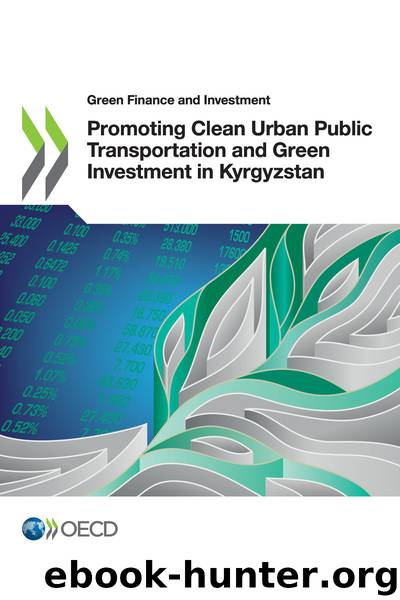Promoting Clean Urban Public Transportation and Green Investment in Kyrgyzstan by OECD

Author:OECD
Language: eng
Format: epub
Tags: development/regions/governance/environment
Publisher: OECD Publishing
Published: 2019-09-25T00:00:00+00:00
Figure 6.6. Average weighted interest rates for newly issued credits, 1996-2018 (by maturity)
Source: National Bank of the Kyrgyz Republic (www.nbkr.kg).
The general level of dollarisation of the total loan portfolio has decreased significantly, from 63.2% in 2008 to 37.9% in 2018 (on average for the respective year), helping to reduce currency risks.57 The official average USD/KGS exchange rate in 2010 was 45.99 and 68.84 in 2018, meaning a depreciation of 49.7% (with the sharpest decline in 2015).58 The National Bank has continued to adhere to the floating exchange rate regime existing in the country. The bank’s exchange rate interventions – such as purchasing gold on the domestic market59 – have helped to smooth the sharp exchange rate fluctuations (NBKR, 2018[22]).
As of March 2019, the total deposits of individual persons in commercial banks equalled KGS 73 710 million (64.9% in national currency), those by legal entities equalled KGS 50 127 million (52.9% in national currency), while those by non-residents were KGS 9 932 million (19.8% in national currency).60 An important milestone was the adoption of the law and respective agency on protecting the deposits of individuals (Law No. 78 of 7 May 2008 “On protection of bank deposits”61).
Based on a recent NBKR survey of commercial banks’ clients, domestic banks forward 61.9% of the loan portfolio to the production sector (GDP) and 15.0% to finance imports (NBKR, 2018[18]).62
Only 2% of the total volume of all credits of KGS 130 629 million was in the transport sector, namely KGS 2 570 million (compared to at least 27.5% in the trade sector, for instance). Compared to other sectors – such as trade or agriculture63 – there is no substantial difference between the ratio of credits taken in national currency (1.9% of all credits) and foreign currency (2.1% of all credits), respectively.
As can be seen in Figure 6.7, the sectoral structure of the loan portfolio also shows high concentration since trade (through banks) and agriculture (through non-bank financial institutions) account for 46.3% of all loans. Whereas in national currency, the largest volume goes to agriculture (KGS 23.4 billion), the largest volume in foreign currency, as well as total volume, is in the trade sector (KGS 19.2 and 36 billion, respectively).
Download
This site does not store any files on its server. We only index and link to content provided by other sites. Please contact the content providers to delete copyright contents if any and email us, we'll remove relevant links or contents immediately.
International Integration of the Brazilian Economy by Elias C. Grivoyannis(75635)
The Radium Girls by Kate Moore(11634)
Turbulence by E. J. Noyes(7717)
Nudge - Improving Decisions about Health, Wealth, and Happiness by Thaler Sunstein(7261)
The Black Swan by Nassim Nicholas Taleb(6783)
Rich Dad Poor Dad by Robert T. Kiyosaki(6192)
Pioneering Portfolio Management by David F. Swensen(6089)
Man-made Catastrophes and Risk Information Concealment by Dmitry Chernov & Didier Sornette(5672)
Zero to One by Peter Thiel(5503)
Secrecy World by Jake Bernstein(4402)
Millionaire: The Philanderer, Gambler, and Duelist Who Invented Modern Finance by Janet Gleeson(4113)
The Age of Surveillance Capitalism by Shoshana Zuboff(3999)
Skin in the Game by Nassim Nicholas Taleb(3978)
The Money Culture by Michael Lewis(3857)
Bullshit Jobs by David Graeber(3847)
Skin in the Game: Hidden Asymmetries in Daily Life by Nassim Nicholas Taleb(3736)
The Dhandho Investor by Mohnish Pabrai(3573)
The Wisdom of Finance by Mihir Desai(3538)
Blockchain Basics by Daniel Drescher(3340)
